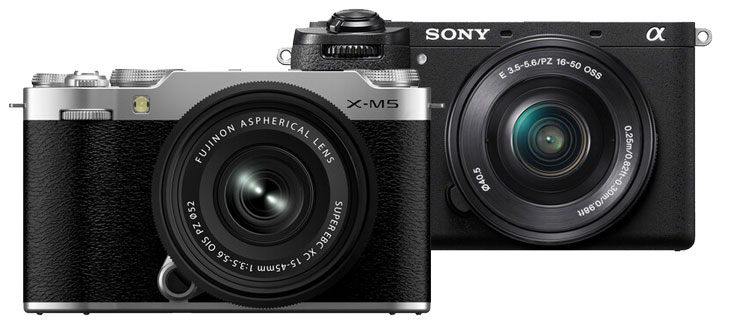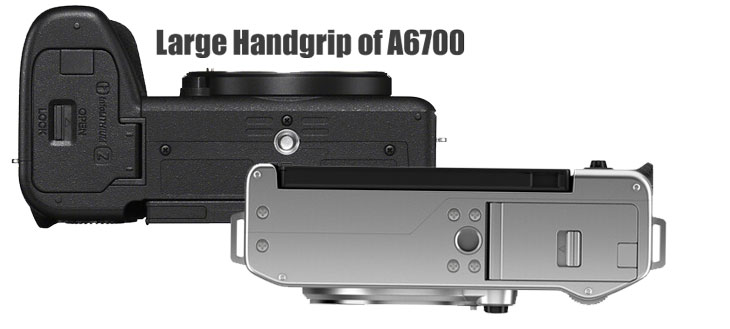
Let’s compare the Fuji X-M5 versus the Sony A6700 camera. We have compared the photographic & videography features in a separate table, so you can easily understand which camera is best for you.
If you are a photographer, which camera should you buy? Again, if you are a content creator, videographer, or wedding filmmaker, which camera should you choose?
Take a look at the specification comparison table below, where we have highlighted the major differences between the two cameras. They also have some similarities, but the good thing is that the Fuji X-M5 camera is able not only to compete but also to uplift the competition bar by upscaling the core specifications.
Fuji X-M5 vs Sony A6700 – 15 Major Differences for Photographers
| Feature | Fuji X-M5 | Sony A6700 |
|---|---|---|
| Sensor Resolution | 26.1 MP APS-C CMOS | 26 MP APS-C Exmor R BSI CMOS |
| Image Processor | X-Processor 5 | BIONZ XR |
| ISO Range (Photography) | 160 to 12,800 (Extended: 80 to 51,200) | 100 to 32,000 (Extended: 50 to 102,400) |
| Autofocus Points (Photo) | 425 Phase Detection Points | 759 Phase Detection Points |
| Autofocus Sensitivity | -7 EV | -3 EV |
| Continuous Shooting | Up to 30 fps (Electronic, cropped) | Up to 11 fps (Mechanical & Electronic) |
| Viewfinder | No Viewfinder | 2.36M-dot OLED Viewfinder |
| Shutter Speed (Mechanical) | 1/4000 to 30 seconds | 1/8000 to 30 seconds |
| Mechanical Shutter | Yes | Yes |
| Image Stabilization | NA | 5-Axis In-Body Image Stabilization (IBIS) |
| Sensor Type | Standard CMOS | Backside Illuminated (BSI) CMOS |
| Weather Sealing | Yes (Dust & Water Resistant) | Yes (Dust & Moisture Resistant) |
| Battery Life (Stills) | Approx. 460 shots | Approx. 570 shots |
| Weight | 355g (Body Only) | 493g (Body Only) |
| Memory Card Slot | Single SD UHS-I Slot | Single SD UHS-II Slot + CFexpress Type A |
Quick Analysis of Specification Differences between the two
The core specifications of the Fuji X-M5 camera look very impressive when compared with the Sony A6700 camera.
If you are a photographer, then of course you will miss the sensor-shift image stabilization in the Fuji X-M5, which is present in the Sony A6700.
Having image stabilization in your camera is really important if you shoot images in low-light environments. The image sensor compensates for hand movements even when you are using a slow shutter speed, resulting in neat and clean images.
Another feature that will help the Sony A6700 camera is the high ISO range, which is expandable from 50 up to 102400.
But wait, we still have some significant differences that might affect your choice. Another big difference for photographers to consider is the continuous shooting speed. If you don’t want any rolling shutter effect visible in your images, you have to use the mechanical shutter, as the electronic shutter can cause rolling shutter effects, especially with non-stacked sensors.
Autofocus Sensitivity and Tracking
Fuji X-M5 vs Sony A6700 – 15 Major Video-Related Differences
| Feature | Fuji X-M5 | Sony A6700 |
|---|---|---|
| MAX Video Resolution | 6.2K up to 30 fps | 4K up to 120 fps |
| Slow-Motion Video | 1080p at 240 fps | 4K at 120 fps, FHD at 240 fps |
| Video Codec | H.264/H.265 (HEVC) | H.264/H.265 (HEVC), XAVC S-I |
| Video Bitrate | 400 Mb/s | 600 Mb/s |
| Video Recording Limit | 50 minutes in 4K | No Recording Limit |
| Log Profiles | F-Log, F-Log 2 | S-Log 3, S-Cinetone |
| Autofocus Points (Video) | 425 Phase Detection Points | 759 Phase Detection Points |
| Autofocus Features | Face/Eye Detection | Real-time Tracking, Eye AF for Video, AI framing |
| External Recording | 4:2:2 10-bit via HDMI | 4:2:2 10-bit via HDMI |
| Viewfinder for Video | No EVF | Yes, 2.36M-dot OLED Viewfinder |
| Display Type | 3-Way Tilting LCD | Fully Articulating LCD |
| Video Stabilization | Electronic | 5-Axis IBIS + Active Mode for Video + Gyro |
| Audio Inputs | 3.5mm Mic Jack, 3.5mm Headphone Jack | 3.5mm Mic Jack, 3.5mm Headphone Jack |
| Mobile Streaming | No | Yes (IP Streaming 4K) |
video core specifications
Let’s compare the video core specifications between the Fuji X-M5 and the Sony A6700 cameras.
We have an open gate option in the Fuji X-M5, which videographers will love, especially for professional filmmaking, allowing them to decide the format and ratio for an entire scene. It’s better to record in open gate. In addition, we have options like Full HD mode at 240 frames per second for capturing slow-motion videos.
However, if you compare the X-M5’s features against the Sony A6700, you will miss the higher-resolution open gate mode. But aside from that, the Sony A6700 offers 4K @ 120 frames per second and can also record Full HD videos at 240 frames per second. The bitrate is approximately 600 Mbps, which is better than the X-M5’s 400 Mbps, even though Fuji offers a 6.2K open gate recording option.
A higher bitrate means more color information, and this will definitely help Sony users a bit more. In addition, we have a dedicated AI chip in the Sony A6700, which enhances autofocus tracking performance in video mode, including AI-based auto framing.
The good news is that Fuji is also improving their autofocus modes in the new X-M5 camera. Similar to Sony, they have introduced a product feature mode in the X-M5, showing Fuji is slowly trying to compete with Sony’s features in the A6700 camera.
Aside from all these features, the Sony A6700 has a 2.36-million-dot electronic viewfinder, which may not directly help with filmmaking, but is still a useful feature. However, the biggest factor is the presence of a sensor-shift image stabilization system.
With sensor-shift image stabilization, we can use active mode in video on the Sony camera to achieve smooth and stable footage. Sony also offers a gyro-based image stabilization system, which can smooth out footage like a GoPro when processed with special software.
Conclusion – Best Camera for Video
When you compare all these features, the Sony A6700 looks more appealing. However, if you are a Filmmakers (Independent or Short Films) prefer the open-gate recording format, you can go with the Fuji X-M5. But if you’re asking which one is more usable and practical camera, for
- For Wedding Cinematographers
- For Traditional Videographers (Corporate, Documentaries):
- For Content Creators
The Sony A6700 is more usable, with its 4K 120 FPS mode, advanced autofocus tracking with a dedicated AI chip, and hybrid image stabilization, which is the better option. The Sony A6700 simply offers a more advanced set of features.
Final Recommendations:
- Fuji X-M5 is recommended for filmmakers who need open gate recording and prefer high-resolution control.
- Sony A6700 is a all-in-one all-rounder for content creators, wedding cinematographers, and traditional videographers, features advanced autofocus, 4K 120 FPS, and Excellent stabilization features.
Fuji X-M5 Price
Fujifilm X-M5 Body: £799 / €899- B&H Store
Fujifilm X-M5 + XC 15-45 Kit: £899 / €999 – B&H Store
Sony A6700 Price
Sony A6700 Body: $1398 B&H Store | Amazon.com
Sony A6700 with Kit Lens: $1498 – B&H Store and Amazon.com
Support us – Use or affiliate link Amazon.com | B&H Store for the next purchase u make – it helps us








I really like your review. It’s clear, it’s expressed in understandable terms, it’s empathetic…. it’s well-written… and it seems reliable (‘seems’ because I am a layman.. and I don’t have enough technical knowledge or understanding to give a reasonable assessment beyond saying ‘seems’; but, judging by all the other criteria.. language, layout, amount of detail… I trust you!).
Thank you.